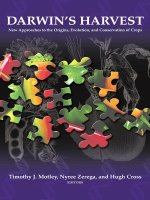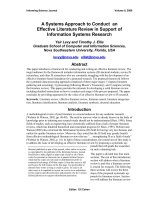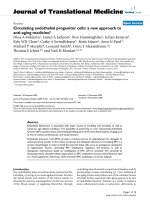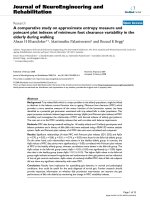A new material to reduces curing time and improve curing reproducibility of lead–acid batteries doc
Bạn đang xem bản rút gọn của tài liệu. Xem và tải ngay bản đầy đủ của tài liệu tại đây (723.3 KB, 7 trang )
Journal of Power Sources 158 (2006) 1133–1139
SureCure
®
—A new material to reduces curing time and improve
curing reproducibility of lead–acid batteries
David P. Boden
∗
, Daniel V. Loosemore, G. Dean Botts
Hammond Lead Products Division, Hammond Group Inc., 2323 165th Street, Hammond, IN 46320, USA
Received 3 January 2006; accepted 9 February 2006
Available online 4 April 2006
Abstract
This paper introduces a technology that considerably reduces the time to cure the positive plates of lead–acid batteries. In each of several
full-scale trials at automotive and industrial battery manufacturers, the simple replacement of 1 wt.% of leady oxide with finely-divided tetrabasic
lead sulfate (SureCure
TM
by Hammond Group Inc.) is shown to accelerate significantly the conversion of tribasic lead sulfate (3BS) to tetrabasic
lead sulfate (4BS) in the curing process while improving crystal structure and reproducibility. Shorter curing times result in reduced labour and
energy costs, as well as reduced fixed (curing chambers and plant footprint) and working (plate inventory) capital investment.
© 2006 Elsevier B.V. All rights reserved.
Keywords: Curing time; Capacity; Lead–acid battery; Tetrabasic lead sulfate; Tribasic lead sulfate; SureCure
®
1. Introduction
The curing of positive plates for lead–acid batteries is a criti-
cal operation. During this process, the chemical and physical
structure of the active-material is established and the plates
develop the strength that is required for subsequent mechanical
handling. When a paste mix is prepared by conventional meth-
ods, the primary compounds present are tribasic lead sulfate
(3BS) (3PbO·PbSO
4
·H
2
O = 3BS), unreacted lead oxide (PbO),
and free lead. It has become apparent to battery manufacturers
that a high concentration of 3BS in the positive plates improves
the life of batteries. This is the case for both automotive and
industrial products. Therefore one of objective of curing is to
convert the 3BS (4PbO·PbSO
4
= 4BS) formed during paste mix-
ing to tetrabasic lead sulfate (4BS). The other important goal is
to oxidize residual free lead in the active material to lead oxide,
i.e.,
3PbO · PbSO
4
·H
2
O + PbO → 4PbO · PbSO
4
+ H
2
O (1)
Pb +
1
2
O
2
→ PbO (2)
∗
Corresponding author. Tel.: +1 219 989 4060; fax: +1 219 989 4071.
E-mail address: (D.P. Boden).
These reactions take place under different conditions. In con-
ventional curing, the conversion of 3BS to 4BS is effected by
heating the pasted plates for severals hours at a temperature of
about 80
◦
C (176
◦
F) in air that has having a relative humidity
of about 95%. Following this, the temperature and humidity are
both reduced to allow the plates to dry slowly. During this stage,
air enters the porous structure of the plate and reacts with the
free lead to produce ␣-PbO. It is important not to let the rela-
tive humidity decrease too quickly because once the moisture
content of the active material falls below 5 wt.% the oxidation
rate of the free lead reduces appreciably. Large curing chambers
capable of holding a shift’s worth of plates or more are typically
used in battery plants. These have controls to adjust temperature
and humidity over wide ranges. Battery manufacturers employ
a variety of temperature–humidity–time profiles and it is not
uncommon for the curing process to take several days.
Despite numerous refinements to curing chambers over the
years, curing remains the last completely un-automated process
in battery manufacturing. In addition, numerous other problems
exist with this process, namely, i.e. energy, labour and capital
intensive, curing times are frequently uncertain, and the chemi-
cal characteristics of the plates are variable. Battery plants may
require tens of curing chambers to handle plates, and these
occupy space that could be more profitably used for more pro-
ductive purposes. Large numbers of plates quarantined in curing
0378-7753/$ – see front matter © 2006 Elsevier B.V. All rights reserved.
doi:10.1016/j.jpowsour.2006.02.057
1134 D.P. Boden et al. / Journal of Power Sources 158 (2006) 1133–1139
Fig. 1. Effect of 1 wt.% SureCure
®
(median particle size = 0.8 m) on curing
of automotive positive paste and plates—Company A.
Fig. 2. Effect of 1 wt.% SureCure
®
(median particle size = 0.8 m) on curing
of automotive battery positive paste and plates—Company B.
chambers increase working capital. Clearly, considerable eco-
nomic benefits would result from an improved process.
2. The SureCure
®
process
A new technologyfor curing has been developed and involves
the use of finely-divided 4BS (median particle size <0.8 m) as
an additive to the paste mix. This is a bright white dry powder
with a 3BS content greater than 95% and has been given the trade
name SureCure
®
. It has been found that 1 wt.% of SureCure
®
(by weight of oxide) in the mix is sufficient to cause significant
amounts of 4BS crystals to be formed in the paste before curing
Fig. 3. Effect of 1 wt.% SureCure
®
(median particle size = 0.8 m) on curing
of industrial battery paste and plates—Company C.
Fig. 4. Effect of 1 wt.% SureCure
®
(median particle size = 0.8 m) on curing
of industrial paste and plates—Company D.
and in the plates during curing. The amount formed prior to
curing depends on the paste temperature. The 4BS is added to
the paste batch with the other solids and in all other respects
the paste-mixing procedure is unchanged. The small addition
of 4BS does not affect either the density or the plasticity of the
paste and therefore pasting operations are unaffected.
The small 4BS crystals act as nucleation sites for the forma-
tion of more 4BS during paste mixing and accelerate conversion
of 3BS to 4BS during curing. By eliminating energy of nucle-
ation, 4BS readily grows on the existing particles rather than
expending the energy required to form new crystals.
Table 1
4BS concentrations (wt.%) in plates from multiple curing trials using 1 wt.% SureCure
®
in the paste mix
Trial no. Paste mix Pasted plate Curing time (h) End of cure
2681824
1 19.8 14.3 21.8 60.7 66.3 66.1 69.9 67.2
2 12.2 15.9 17.8 64.3 64.3 69.3 64.0
3 14.3 18.4 56.9 64.7 61.8 68.6
4 21.4 24.1 62.6 68.9 67.4 64.0
5 63.7
Avg. 16.0 16.5 20.5 60.7 62.8 66.0 67.1 65.95
D.P. Boden et al. / Journal of Power Sources 158 (2006) 1133–1139 1135
Fig. 5. Scanning electron microscope image of positive active material after
conventional curing. Magnification = 3000.
A number of full-scale trials with this material have been
conducted in automotive and industrial battery plants. In every
case, the time required for formation of 4BS has been short-
ened appreciably and the uniformity of the cured plates has
been considerably improved. Typical automotive and indus-
trial paste mixes were made using conventional commercial
paste mixers. To these pastes was added 1 wt.% of 4BS with a
median particle size of around 0.8 m. The standard paste mix-
ing and curing processes used by the battery manufacturers were
followed and the plates were pasted and tunnel-dried by conven-
tional pasting machines and driers, respectively. The automotive
plates were generally stacked on pallets, while the industrial
plates were either stacked or racked depending on the manu-
facturer’s preference. The plates were cured in standard com-
mercial curing chambers following the manufacturer’s normal
procedure.
To evaluate the results of the additive, samples of paste were
taken at the end of the mixing process and samples of the pasted
plates were collected both at the take-off station and at intervals
during the curing process. Active material was removed from
the plates, immediately placed in a freezer at −18
◦
C(0
◦
F) and
subsequently vacuum dried. The material was then analyzed by
X-ray diffraction to determine the phases present using a Rigaku
Miniflex X-ray analyzer with software adapted for calculation
of concentrations of phases in battery plates. Scanning elec-
tron microscope images were also obtained at a magnification
of 3000 to determine crystal size. In some cases, BET specific
surface-area and porosity measurements were made.
3. Automotive battery plate paste-mixing and curing
A summary of the data obtained from trials carried out with
two automotive battery manufacturers is shown in Figs. 1 and 2.
Company A and Company B employed different curing pro-
cesses and equipment, although in both cases the plates were
placed on pallets in stacks of approximately 20 cm high. In the
case of Company A, the process was intended to produce 4BS
by employing a schedule in which the curing temperature was
low initially and then increased with time to 80
◦
C (176
◦
F). At
Company B, the curing chamber temperature was maintained at
54
◦
C (130
◦
F) throughout the process. In both companies, the
relative humidity was maintained at >95% until the drying cycle
was started.
It is clear that the addition of only 1 wt.% 4BS to the paste mix
accelerated conversion of 3BS to 4BS. In the case of Company
A, some conversion took place in the paste mixer and virtu-
ally complete conversion had taken place after 6 h in the curing
chamber. Without the additive, no conversion occurred untilafter
18 h in the curing chamber. At the end of the curing cycle, the
untreated plates contained only 35% 4BS compared with 66%
in the treated plates.
In the case of Company B, a significant amount of 4BS had
formed in the paste mixer before the plates were pasted. The
reason for this is that the peak paste-mixing temperature was
approximately 63
◦
C (145
◦
F), i.e., 5
◦
C(9
◦
F) higher than those
of Company A. This small increase in peak paste temperature
was sufficient to accelerate formation of 4BS in the paste mixer.
The paste contained 40–50% 4BSLS before it was dispensed
into the pasting machine hopper. The 4BS levels in the plates of
Company B were also higher than in these of Company A. This
was because Company B employed a higher sulfation level in
its paste.
The plates that contained 4BSLS werealso very reproducible.
This is shown in Table 1 which provides data from several sep-
arate trials carried out at Company A. These data yield some
important conclusions:
Fig. 6. Crystal structure of positive plates taken from different locations in the curing chamber after conventional curing.
1136 D.P. Boden et al. / Journal of Power Sources 158 (2006) 1133–1139
(i) Addition of 1 wt.% of finely-divided 4BS to the paste mix
accelerates the conversion of 3BS to 4BS in the curing pro-
cess.
(ii) 4BS can be formed in the curing chamber at a temperature
of 54
◦
C (130
◦
F).
(iii) 3BS conversion to 4BS takes place in the paste mixer at a
peak pasting temperature above 63
◦
C (145
◦
F).
(iv) Conversion of 3BS to 4BS does not take place at these
temperatures in the absence of the finely divided TTBLS
additive.
4. Industrial battery plate paste-mixing and curing
Results from trials performed in industrial battery plants
are shown in Figs. 3 and 4. As in the trials on automotive
plate curing, the two companies used different curing processes.
Consequently, different results were obtained in each case. Nev-
ertheless, in all tests the formation of 4BS was considerably
enhanced when the additive was used. In the case of Company
C(Fig. 3) the plates were placed on notched racks and the curing
profile began with a slow ramp up in temperature from ∼54
◦
C
(130
◦
F) to ∼77
◦
C (170
◦
F), followed by several hours at the
higher temperature. Without additive, no 4BS was present in
the paste and only began to form 9 h after the curing cycle had
commenced. This coincided with the end of the ramp up to high
temperature. After 24 h, when the drying phase of the curing
process was started, the 4BS concentration was ∼75 wt.%. By
contrast, inclusion of the additive caused considerable conver-
sion of 3BS to 4BS (60 wt.%) in the paste mixer. Over 70 wt.%
4BS was obtained after only 2 h in the curing chamber while
the process was still in the ramp-up phase. In summary, these
data show that the additive promotes the formation of 4BS in the
paste mix and that conversion of 3BS to 4BS can be achieved
during curing at temperatures between range 55 and 60
◦
C
(130–140
◦
F).
The investigation at Company D was conducted to determine
whether it was possible to achieve good conversion of 3BS to
4BS at much lower temperatures by use of the additive. The
plates were stacked on pallets and the curing room was held
at ∼50
◦
C (125
◦
F) with a relative humidity >95%. The peak
paste-mixing temperature was 60
◦
C (140
◦
F). Under these con-
ditions, the untreated paste and plates developed very little 4BS,
even after 100 h in the curing chamber (Fig. 4). By contrast,
the treated paste contained about 5 wt.% 4BS and this rapidly
increased to 30–35 wt.% after 1 h in the curing chamber. Com-
plete conversion took place after about 5 h. These data confirm
that the additive enables the development of 4BS to occur at
temperatures well below those traditionally used by the battery
industry.
5. Crystal size and uniformity
The size and uniformity of the 4BS crystals are very impor-
tant. Large crystals will result in longer plate formation times.
Uniformity is also essential for all crystals to be converted to
active material at the same rate and thus ensure that plates are
reproducible. Wide variations in crystal size can cause signif-
icant changes in charge acceptance and variable performance
from plate to plate. In conventional curing it is common for
the crystal size of 4BS to vary considerably, due to the diffi-
culty in initiating the conversion of 3BS to 4BS. As mentioned
earlier, the latter requires high temperature and humidity, but
Fig. 7. Scanning electron micrograph of positive active material (1 wt.%
SureCure
®
added) at different stages of curing.
D.P. Boden et al. / Journal of Power Sources 158 (2006) 1133–1139 1137
Fig. 8. Effect of 1 wt.% SureCure
®
(median particle size = 0.8 m) on free-lead
oxidation in positive plates during curing.
once the reaction has started 4BS crystals form quickly and can
grow to a large size within a short time. Because of varying
thermodynamic conditions from place to place in the curing
chamber, and the influence position of plates on the racks or
stacks, 4BS crystal growth does not begin simultaneously in
all the plates. Therefore, crystal growth can be variable from
plate to plate and from place to place within the plate. This
situation is improved by the use of a 4BS nucleation additive
because the energy of crystallization is decreased. Consequently,
crystal growth is facilitated at a lower temperature and takes
place uniformly on the 4BS ‘seeds’ distributed in the active
material.
A scanning electron micrograph of typical positive-plate
active material at the end of conventional curing is shown in
Fig. 5. The large, angular crystals are 4BS and they exhibit a
wide variety of crystal sizes. Further examples of variability in
4BS crystal development are given in Fig. 6, which presents
micrograph of positive active-material collected from plates at
different locations in the chamber after conventional curing.
Differences in crystal morphology will lead to variations in
charge-acceptance during plate formation (large crystals charge
more slowly) and in the initial capacity of batteries. Differences
in battery life may also eventuate since batteries made from
Fig. 9. Effect of 1 wt.% SureCure
®
(median particle size = 0.8 m) on free-lead
oxidation in negative plates during curing.
plates with poor crystal development will suffer from premature
softening and shedding of active material. With as little as1 wt.%
SureCure
®
added to the positive paste mix, the crystal structure
is improved markedly. This is illustrated in Fig. 7 which shows
electron micrographs at 3000 magnification of positive active-
material from the plate take-off station, after 2 h in the curing
chamber, and at the end of the curing process. The plate at the
take-off station has a high concentration of 4BS (∼60 wt.%) that
increases to approximately 70 wt.% after 2 h in the chamber and
to 85 wt.% at the end of curing. This demonstrates that the pres-
ence of SureCure
®
promotes formation of 4BS in the paste mix
before the plates are pasted. The implications of this are very
significant since it shows that the crystallization phase of the
curing process can be shortened or even eliminated. The crystal
uniformity is also noteworthy and the crystal size changes very
Fig. 10. Effect of 1 wt.% SureCure
®
on (a) cold-cranking amperes, (b) reserve
capacity and (c) 20 h rate capacity of automotive batteries.
1138 D.P. Boden et al. / Journal of Power Sources 158 (2006) 1133–1139
Fig. 11. Effect of 1 wt.% SureCure
®
(median particle size = 0.8 m) on initial
capacity of motive-power batteries.
little from pasting (∼5–7 m) to the end of curing (∼10 m).
These features will improve both the charge acceptance and the
consistency of plate formation. Consequently, more efficient for-
mation will occur and the variation in initial capacity will be
reduced.
6. Free-lead oxidation
The curing process serves to oxidize free lead in addition to
the development for of the crystal structure. It has been found
that use of SureCure
®
speeds up the oxidation of free lead
in both positive and negative plates. By way of example, data
obtained from industrial positive and negative plates subjected
to a curing profile at 80
◦
C and 95% relative humidity are pre-
sented in Figs. 8 and 9, respectively. For positive plates, the
times required to achieve a free-lead concentration of the usu-
ally accepted 2 wt.% is about 18 h and 28 h with and without
SureCure
®
, respectively. For negative plates, the reduction in
free lead to 4 wt.% is achieved in 8 h with the additive while
18 h are required without additive. The time required to obtain
2 wt.% free lead is approximately 26 h in both cases.
7. Initial capacities of batteries
Initial capacity testing has been carried out on both automo-
tive and motive-power batteries, and life testing is in progress.
7.1. Automotive batteries
Data from cold-cranking, reserve capacity and 20 h capacity
testing are given in Fig. 10. In all of these tests, the batteries
that contained SureCure
®
in the positive plates give improved
performance.
7.2. Industrial batteries
Results from initial capacity tests on motive-power batteries
are presented in Fig. 11. Compared are the first 10 cycles from
two 12 V-425 Ah batteries. The battery with 1 wt.% 4BS yields
a higher capacity.
7.3. Life testing
As noted above the principal reason for producing batteries
with 4BS in the positive plates is that this increases life, partic-
ularly in cycling applications. Unfortunately, life testing takes
a considerable amount of time and in this study it has yet to be
completed. Nevertheless, data exist for golf-car batteries up to
550 cycles, as shown in Fig. 12. These tests were carried out on
two full golf-car battery sets that were charged and discharged
by conventional Lester dischargers and chargers.
It can be seen that at this point batteries with SureCure
®
have
given higher capacity than the standard product throughout the
Fig. 12. Cycle-life of golf-car batteries with and without SureCure
®
.
D.P. Boden et al. / Journal of Power Sources 158 (2006) 1133–1139 1139
test. (Note, in other respects the compositions of the cured pastes
of the two sets was the same.)
8. Conclusions
SureCure
®
has been found to be a remarkably effective addi-
tive for both positive and negative plates. The following obser-
vations are made:
(i) The additive causes formation of 4BS in the paste mix and
this reduces the need to develop this material during the
curing process.
(ii) Where low paste-mixing temperatures are used that result
in reduced 4BS formation in the paste mix, the additive
promotes rapid conversion of 3BS to 4BS in the curing
chamber at temperatures above 55
◦
C (130
◦
F).
(iii) The additive also:
- improves the uniformity of the 3BS to 4BS conversion
- improves crystal size uniformity
- prevents the formation of very large, difficult to form,
4BS crystals
- shortens the time for free-lead oxidation in both positive
and negative plates
- increases the initial capacity of industrial batteries
- increases the cold-cranking amperes, reserve capacity
and 20 h rate capacity of automotive batteries
- maintains capacity increase for more than 500 deep
cycles.
These benefits give a significant reduction in curing times
and improved performance from batteries.









